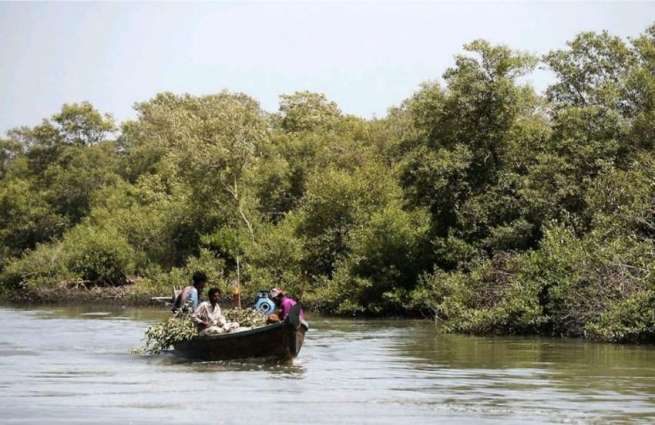Environmentalists define biodiversity loss as the decline in the number of species, genetic variability or the biological communities existing in a prescribed area
Dr. Saeed Ahmad Ali: Environmentalists define biodiversity loss as the decline in the number of species, genetic variability or the biological communities existing in a prescribed area. This loss in the variety of life can lead to a severe breakdown in the smooth functioning or existence of the ecosystem where decline is being happened, they define.
According to the World Wide Fund for Nature (WWF)- Pakistan Chapter study, the total mangroves cover in the mighty Indus delta is approximately 129,000 ha and about 3,000 ha along the Baluchistan Coast in the Gawatar Bay, Miani Hor and Kalmat Khor areas. It means that in Pakistan over 600,000 hectares of Indus delta and coastline is under mangrove forestation cover.
The coastal and delta communities, marine and terrestrial life of the coast are dependent and entwined to this ecosystem, it reveals.
The Indus Delta therefore helps survive the 97 percent of the total mangrove forest, which include around 37 percent of the Delta area, while the remaining 3 percent is supported by three pockets on the Balochistan Coast, the report reveals.
The study report further reveals that a significant increase in marine water pollution, reduction in the river water supply, alarming overharvesting of the mangroves by the local communities in the Indus Delta, coastal erosion and sedimentation, are the major causes of this loss.
The River Indus had been the sixth largest delta of the world, having a shape of the claw of a bird, and was then the home to hundreds of thousands species, which were fighting the war of their survival due to scarce water in the river streams for more times around the year, manager Natural Resource Management (NRM) at WWF-Pakistan, Saeed-ul-Islam told APP.
The vital flow of the mighty Indus River into the Indus delta is being polluted heavily by a variety of industrial waste and dangerous effluents of sewage. The area is also affected by increased salinity caused due to enriched fertilizers’ nutrients coming from upstream irrigation, he informed.
To a query, he said that the overwhelming pressure of the population increasing at a fast pace is also another main reason to the clearing of the mangroves and its associated green cover for industrial and agricultural uses.
The urban expansion and developmental projects were also undermining the livelihoods of the coastal communities and thereby exacerbating their poverty, which is a considerable loss to the entwined ecosystem, he added.
Another report of the United Nations’ on biodiversity finds one-million plant and animal species on earth are facing extinction, due to capitalism activities finding that indigenous people or communities are better for nature.
This report has expressed concerns over a new sweeping and first-ever global calculation on biodiversity summing up the irreversible nature of human damage and the potential threat which it poses to life on Earth.
With an astute statistic, over one million plant and animal species are facing extinction due to human damages to green nature and wildlife, it finds. Around 145 authors from 50 regions and countries, have summed up the Global Assessment Report(GAR) comprising on 15,000 scientific papers to conclude that all kinds of species including plants, mammals, amphibians, birds, insects, marine life and terrestrial life, are disappearing at a alarming pace due to human activity.
It further reveals that more than 300 unique mammal species had disappeared from the face of the earth since the last ice age, some 130,000 years ago, adding humans have been around for about 200,000 years.
United Nations Environment Programme (UNEP) study reveals that half Of the world’s mangrove forests have been lost during the past 40 years.
Similarly urban development, deforestation due to developmental projects, sea level rise, industrial aquaculture and soil erosion factors had affected their growth.
It is worth mentioning here that protecting and restoring Mangroves’ decline has been declared a top priority agenda by the two major global bodies’ initiatives are working to address global Climate change issues which included European Union’s flagship climate change programme and the Global Climate Change Alliance called (GCCA+). Dr .Mahmood Khalid Qamar, a noted mangrove forest expert having his Ph.D research work on the subject told APP that mangroves were one of best allies on earth in the fight against climate change, adding yet it was good omen that several global initiatives were being taken to protect them.
To a query he said that the mangroves had enormous capacity for absorbing toxic gases in the environment and filtering air by retaining carbon dioxide and other greenhouse gases.
Professor Benjamin Horton, Director of the Earth Observatory at Singapore has commented in a recent report which was calculated on global threats to mangroves cover revealing that these forest covers are an interesting intricate ecosystem which allows its tree roots to adapt and survive at high temperatures and salinity levels.
"But we could lose almost all mangroves by 2050 if rapid depletion of their cover is not halted immediately and if the current carbon gases emission trajectory is not lowered," he cautioned. It is pertinent to mention here that Special Assistant to Prime Minister(SAPM) on Climate Change, Malik Amin Aslam has recently announced in a statement that under the Prime Minister Imran Khan’s Ten Billion Tree Tsunami Programme (TBTTP), a comprehensive initiative has been hammered out to massively boost coastline and delta areas of Baluchistan and Sindh under mangroves plantation.
The total mangroves cover in the country spreads over an area of around 1463.59 km, sources in WWF told APP, adding the cover would be increased manifold under the prime minister Imran Khan’s new initiative of one billion mangroves tree plantation plan, under his Clean Green Pakistan vision.




